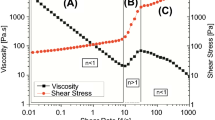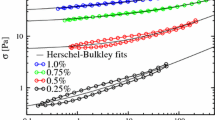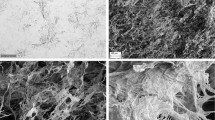Abstract
This paper discusses the practical application of a bucket vane viscometer in the characterization of novel nanofibrillated cellulose suspensions. Specifically, we use two different grades of nanocellulose, Masuko grinded and TEMPO oxidized ones. We work at the consistency range of 1–2.3 % w/w. We find, in agreement to more accurate rheometer based experiments, that both these materials behave in a highly non-linear manner. Thus, as we discuss in this paper, using a wide gap device necessitates the use of a correction algorithm in the conversion of the angular velocity to global shear rate to access the materials intrinsic, geometry independent, flow behavior. Furthermore, from the application viewpoint, we find that the classically measured low shear rate viscosity is not a good quantity to characterize these materials.



Similar content being viewed by others
References
Agoda-Tandjawa G, Durand S, Gaillard C, Garnier C, Doublier JL (2012) Rheological behaviour and microstructure of microfibrillated cellulose suspensions/low-methoxyl pectin mixed systems. Effect of calcium ions. Carbohydr Polym 87(2):1045–1057
Ahola S, Myllytie P, Österberg M, Teerinen T, Laine J (2008) Effect of polymer adsorption on cellulose nanofibril water binding capacity and aggregation. BioResources 3(4):1315–1328
Ancey C (2005) Solving the Couette inverse problem using a wavelet–vaguelette decomposition. J Rheol 49(2):441–460
Barnes H, Carnali J (1990) The vane-in-cup as a novel rheometer geometry for shear thinning and thixotropic materials. J Rheol 34(6):841–866
Barnes HA, Nguyen QD (2001) Rotating vane rheometry—a review. J Non-Newton Fluid Mech 98(1):1–14
Chatzimina M, Gerogiou G, Alexandrou A (2009) Wall shear rates in circular Couette Flow of a Herschel–Bulkley fluid. Appl Rheol 19(3):34288
Corrêa AC, de Morais Teixeira E, Pessan LA, Mattoso LHC (2010) Cellulose nanofibers from curaua fibers. Cellulose 17(6):1183–1192
Coussot P (2005) Rheometry of pastes, suspensions, and granular materials: applications in industry and environment. Wiley, New York
Dimic-Misic K, Puisto A, Gane P, Nieminen K, Alava MJ, Paltakari J, Maloney T (2013a) The role of MFC/NFC swelling in the rheological behavior and dewatering of high consistency furnishes. Cellulose 20(6):2847–2861
Dimic-Misic K, Puisto A, Paltakari J, Alava MJ, Maloney T (2013b) The influence of shear on the dewatering of high consistency nanofibrillated cellulose furnishes. Cellulose 20(4):1853–1864
Divoux T, Tamarii D, Barentin C, Manneville S (2010) Transient shear banding in a simple yield stress fluid. Phys Rev Lett 104(20):1–4
Divoux T, Barentin C, Manneville S (2011) From stress-induced fluidization processes to Herschel–Bulkley behaviour in simple yield stress fluids. Soft Matter 7(18):8409–8418
Divoux T, Grenard V, Manneville S (2013) Rheological hysteresis in soft glassy materials. Phys Rev Lett 110(1):018304
Fisher DT, Clayton SA, Boger DV, Scales PJ (2007) The bucket rheometer for shear stress–shear rate measurement of industrial suspensions. J Rheol 51(5):821–831
Haimoni A, Hannant D (1988) Developments in the shear vane test to measure the gel strength of oilwell cement slurry. Adv Cem Res 1(4):221–229
Heirman G, Vandewalle L, Van Gemert D, Wallevik O (2008) Integration approach of the Couette inverse problem of powder type self-compacting concrete in a wide-gap concentric cylinder rheometer. J Non-Newton Fluid Mech 150(2–3):93–103
Herrick FW, Casebier RL, Hamilton JK, Sandberg KR (1983) Microfibrillated cellulose: morphology and accessibility. In: Applied Polymer Symposium Conference: 9 Cellulose Conference No CONF-8205234, vol 37
Horvath AE, Lindström T, Laine J (2006) On the indirect polyelectrolyte titration of cellulosic fibers. Conditions for charge stoichiometry and comparison with ESCA. Langmuir 22(2):824–830
Iotti M, Gregersen ØW, Moe S, Lenes M (2010) Rheological studies of microfibrillar cellulose water dispersions. J Polym Environ 19(1):137–145
Isogai A, Saito T, Fukuzumi H (2011) TEMPO-oxidized cellulose nanofibers. Nanoscale 3(1):71–85
Junka K, Filpponen I, Lindström T, Laine J (2013) Titrimetric methods for the determination of surface and total charge of functionalized nanofibrillated/microfibrillated cellulose (NFC/MFC). Cellulose 20(6):2887–2895
Karppinen A, Vesterinen AH, Saarinen T, Pietikäinen P, Seppälä J (2011) Effect of cationic polymethacrylates on the rheology and flocculation of microfibrillated cellulose. Cellulose 18(6):1381–1390
Karppinen A, Saarinen T, Salmela J, Laukkanen A, Nuopponen M, Seppälä J (2012) Flocculation of microfibrillated cellulose in shear flow. Cellulose 19(6):1807–1819
Kieweg SL, Katz DF (2006) Squeezing flows of vaginal gel formulations relevant to microbicide drug delivery. J Biomech Eng 128(4):540–553
Klein CO, Spiess HW, Calin A, Balan C, Wilhelm M (2007) Separation of the nonlinear oscillatory response into a superposition of linear, strain hardening, strain softening, and wall slip response. Macromolecules 40(12):4250–4259
Krieger IM, Samuel HM (1952) Direct determination of the flow curves of non-Newtonian fluids. J Appl Phys 23(1):147–149
Lasseuguette E, Roux D, Nishiyama Y (2008) Rheological properties of microfibrillar suspension of TEMPO-oxidized pulp. Cellulose 15(3):425–433
Lettinga MP, Manneville S (2009) Competition between shear banding and wall slip in wormlike micelles. Phys Rev Lett 103(24):248302
Manneville S, Salmon JB, Colin A (2004) A spatio-temporal study of rheo-oscillations in a sheared lamellar phase using ultrasound. Eur Phys J E 13(2):197–212
Mewis J, Wagner NJ (2009) Thixotropy. Adv Colloid Interface Sci 147:214–227
Mishra SP, Thirree J, Manent AS, Chabot B, Daneault C (2010) Ultrasound-catalyzed TEMPO-mediated oxidation of native cellulose for the production of nanocellulose: effect of process variables. BioResources 6(1):121–143
Møller PCF, Mewis J, Bonn D (2006) Yield stress and thixotropy: on the difficulty of measuring yield stresses in practice. Soft Matter 2(4):274–283
Nakagaito AN, Fujimura A, Sakai T, Hama Y, Yano H (2009) Production of microfibrillated cellulose (MFC)-reinforced polylactic acid (PLA) nanocomposites from sheets obtained by a papermaking-like process. Compos Sci Technol 69(7):1293–1297
Ovarlez G, Rodts S, Ragouilliaux A, Coussot P, Goyon J, Colin A (2008) Wide-gap Couette flows of dense emulsions: local concentration measurements, and comparison between macroscopic and local constitutive law measurements through magnetic resonance imaging. Phys Rev E 78(3):036307
Pääkkö M, Ankerfors M, Kosonen H, Nykänen A, Ahola S, Österberg M, Ruokolainen J, Laine J, Larsson PT, Ikkala O, Lindström T (2007) Enzymatic hydrolysis combined with mechanical shearing and high-pressure homogenization for nanoscale cellulose fibrils and strong gels. Biomacromolecules 8(6):1934–1941
Pääkkö M, Vapaavuori J, Silvennoinen R, Kosonen H, Ankerfors M, Lindström T, Berglund LA, Ikkala O (2008) Long and entangled native cellulose I nanofibers allow flexible aerogels and hierarchically porous templates for functionalities. Soft Matter 4(12):2492–2499
Puisto A, Illa X, Mohtaschemi M, Alava MJ (2012) Modeling the viscosity and aggregation of suspensions of highly anisotropic nanoparticles. Eur Phys J E 35(1):1–7
Richmond F (2012) The coating of nanofibrillated cellulose onto paper using flooded and metered size press, methods. 12PaperCon
Saarikoski E, Saarinen T, Salmela J, Seppälä J (2012) Flocculated flow of microfibrillated cellulose water suspensions: an imaging approach for characterisation of rheological behaviour. Cellulose 19(3):647–659
Saito T, Kimura S, Nishiyama Y, Isogai A (2007) Cellulose nanofibers prepared by TEMPO-mediated oxidation of native cellulose. Biomacromolecules 8(8):2485–2491
Siró I, Plackett D (2010) Microfibrillated cellulose and new nanocomposite materials: a review. Cellulose 17(3):459–494
Spence KL, Venditti RA, Rojas OJ, Habibi Y, Pawlak JJ (2010) The effect of chemical composition on microfibrillar cellulose films from wood pulps: water interactions and physical properties for packaging applications. Cellulose 17(4):835–848
Spence KL, Venditti RA, Rojas OJ, Habibi Y, Pawlak JJ (2011) A comparative study of energy consumption and physical properties of microfibrillated cellulose produced by different processing methods. Cellulose 18(4):1097–1111
Subramanian R, Hiltunen E, Gane PA (2011) Potential use of micro-and nanofibrillated cellulose composites exemplified by paper. In: Cellulose fibers: bio-and nano-polymer composites, Springer, pp 121–152
Turbak AF, Snyder FW, Sandberg KR (1984) Microfibrillated cellulose—a new composition of commercial significance. Nonwovens SympNotes 37(2):115–124
Walls H, Caines SB, Sanchez AM, Khan SA (2003) Yield stress and wall slip phenomena in colloidal silica gels. J Rheol 47(4):847–868
Yeow YL, Ko WC, Tang PPP (2000) Solving the inverse problem of Couette viscometry by Tikhonov regularization. J Rheol 44(6):1335–1351
Yeow YL, Wickramasinghe SR, Leong YK, Han B (2002) Model-independent relationships between hematocrit, blood viscosity, and yield stress derived from Couette viscometry data. Biotechnol prog 18(5):1068–1075
Acknowledgments
This work was supported by the Effnet program in the Finnish Forest Cluster Ltd. Also, the support from the Academy of Finland through the COMP Center of Excellence, the project number 140268, and within the framework of the International Doctoral Programme in Bioproducts Technology (PaPSaT) are acknowledged.
Author information
Authors and Affiliations
Corresponding author
Rights and permissions
About this article
Cite this article
Mohtaschemi, M., Dimic-Misic, K., Puisto, A. et al. Rheological characterization of fibrillated cellulose suspensions via bucket vane viscometer. Cellulose 21, 1305–1312 (2014). https://doi.org/10.1007/s10570-014-0235-1
Received:
Accepted:
Published:
Issue Date:
DOI: https://doi.org/10.1007/s10570-014-0235-1




